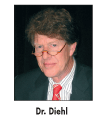Escalated BEACOPP new standard for advanced HL
Long-term results of a German randomized trial suggest that a novel escalated-dose regimen may replace the current chemotherapy standard of care for treatment of advanced-stage Hodgkin lymphoma. Volker Diehl, MD, of the University of Cologne, Germany, presented 10-year follow-up data on behalf of the German Hodgkin Study Group at ASH 2007 (abstract 211).

ATLANTA-Long-term results of a German randomized trial suggest that a novel escalated-dose regimen may replace the current chemotherapy standard of care for treatment of advanced-stage Hodgkin lymphoma. Volker Diehl, MD, of the University of Cologne, Germany, presented 10-year follow-up data on behalf of the German Hodgkin Study Group at ASH 2007 (abstract 211).
For patients with advanced Hodgkin lymphoma (HL), the standard of care regimen consists of COPP (cyclophosphamide, vincristine, procarbazine, prednisone) alternating with ABVD (doxorubicin, bleomycin, vinblastine, dacarbazine). Use of this regimen results in cures in approximately 70% of patients.
BEACOPP (bleomycin, etoposide, doxorubicin, cyclophosphamide, vincristine, procarbazine, and prednisone) was developed by the German Hodgkin Study Group and, in several randomized trials, has demonstrated its efficacy and safety in Hodgkin lymphoma.
The present study (HD9) was a three-arm trial designed to compare two doses (baseline and escalated) of BEACOPP with ABVD-based chemotherapy. Eligible Hodgkin lymphoma patients (n = 1,282) had clinical stage IIB-IIIA disease with risk factors or stage IIIB-IV. Patients from 370 centers were randomized to:
• Four cycles of COPP plus ABVD (arm A)
• Eight cycles of BEACOPP-baseline (arm B)
• Eight cycles of BEACOPP-escalated (arm C)
In the BEACOPP-escalated regimen, the doses of cyclophosphamide, etoposide, and doxorubicin were increased to 192%, 200%, and 140% of the standard doses, respectively. Patients on arm C also received G-CSF support. All patients received radiation therapy to initial bulk and residual tumor.
Five-year follow-up showed that the BEACOPP regimens were statistically superior to the ABVD regimen with respect to both freedom from treatment failure (FFTF) and overall survival (OS) (Diehl V et al: N Engl J Med 348:2386-2395, 2003). (The ABVD arm was closed after 3 years due to significantly inferior progression-free survival, compared with the BEACOPP arms.)
Moreover, outcomes with BEACOPP-escalated were statistically better than with BEACOPP-baseline. Since the escalated-dose regimen was associated with greater toxicity than the standard-dose BEACOPP, patients continued to be followed.
Study results
In the results presented by Dr. Diehl, median follow-up for the 1,196 randomized patients was 112 months. FFTF rates for arms A, B, and C were 64%, 70%, and 82%, respectively, while OS rates were 75%, 80%, and 86% (P < .0001 for overall FFTF comparison; P = .0005 for overall OS comparison).
Significantly, BEACOPP-escalated was superior to BEACOPP-baseline for FFTF (P < .0001) and OS (P = .0053).
“Overall survival was 11% higher with BEACOPP-escalated, compared with ABVD, and progression-free survival was 18% greater,” Dr. Diehl said.
Second malignancies
Second malignancies for the three study arms included secondary acute myeloid leukemias (1, 7, and 14 cases, respectively), non-Hodgkin’s lymphoma (7, 8, and 5 cases), and solid tumors (7, 16, and 9 cases). The overall secondary malignancy rates for the three arms were 6.7%, 8.9%, and 6.8%, respectively.
Importantly, Dr. Diehl pointed out, although the rate of secondary AML/MDS was higher with BEACOPP-escalated in this trial, a follow-up trial of this regimen in 1,502 patients with advanced-stage HL (HD12) found an incidence of only 0.9% at 4 years.
One possible contributing factor is the higher proportion of patients who received additional radiotherapy in the HD9 trial (70%), compared with the HD12 study (39%). In trial HD9, deaths due to Hodgkin lymphoma were 11.5%, 8.1%, and 2.8% for arms A, B, and C, respectively, indicating that the dose-escalated regimen is not associated with a high mortality rate.
When data from three randomized, prospective clinical trials of BEACOPP escalated involving more than 2,000 treated patients are considered, Dr. Diehl concluded, the results demonstrate a complete response rate of more than 90%. With median follow-up of 4 to 10 years, FFTF ranged from 82% to 88% and OS from 86% to 90%, demonstrating a significant improvement over ABVD chemotherapy.
When the efficacy data are coupled with the low incidence of secondary AML/MDS, these results challenge ABVD as the first-line standard of care for patients with advanced-stage HL, he said.